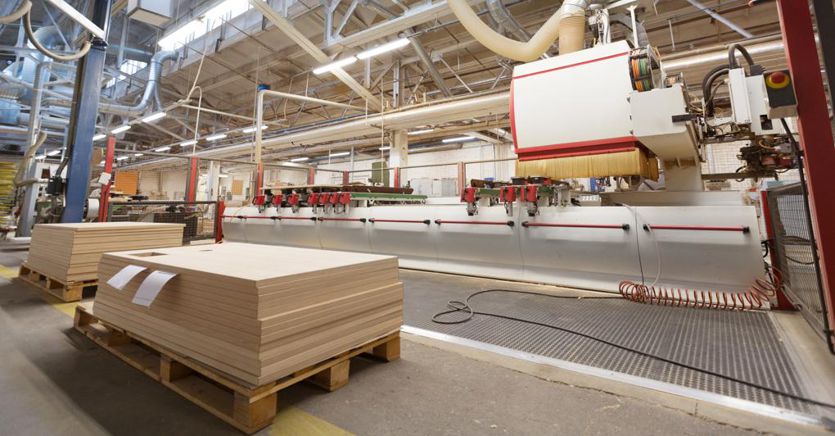«Every day we receive a lot of requests, from all over Italy. Companies that had never contacted us in the past, because they usually bought semi-finished products from abroad. This shows how the market is in trouble and looking for material that is not there or costs too much ». Milena De Rossi is the owner of Mdr Legnami, a Valtellina company that employs 37 people and has a turnover of around 7 million euros. De Rossi, like all his colleagues, is suffering from the shortage of timber arriving from abroad, in particular from Switzerland, the traditional supplier of MDR Legnami. “We don’t have time to fill the warehouses: on the one hand, fewer and fewer logs are arriving, on the other, demand has increased enormously,” explains the entrepreneur. For now, the company has managed to organize itself to keep production rhythms unchanged, but delivery times to customers have lengthened from 10-15 days to a month, a month and a half.
Shortage of raw materials
The shortage of raw materials has been affecting the entire Italian industry for months, which is heavily dependent on foreign countries for many basic components for production. In the case of wood, the paradox is that in Italy there is no lack of raw material: according to Assolegno, in the last 70 years the Italian wooded area has tripled, from 5.6 million hectares to over 11 million and covers 38% of the national surface. Yet, our country imports 80% of the timber used by the industry for its processing. “A paradox that we have been denouncing for years, but which now becomes unsustainable, given the shortage of materials – explains the president of Assolegno, Angelo Luigi Marchetti -. From last autumn to today, the price of round wood (whole logs, to be sawed, ed) has increased between 20 and 30%, while that of semi-finished products has even doubled, passing from 400 euros per cubic meter in September, to 800 euros ”.
Loading…
A national cluster
The solution, even if it will take some time, must be one of industrial policy: «We need to create a national cluster for the management and enhancement of forest resources – says Marchetti -. The 2018 Forestry Consolidation Act has improved the situation, regulating and standardizing the management of the woods. But too little has been done on the industrial front to reorganize a supply chain which, over time, has been lost ». Even if the possibility of harvesting timber were increased, today there would not be enough (or sufficiently large) sawmills and companies to guarantee the volumes required by the market, nor the necessary skills. «In five years we could see significant results – observes the president -. And if we halved the imports, we would bring back to Italy about 600 million euros a year to buy Italian trees and therefore create economies of scale in the area, creating thousands of jobs, with economic, social and environmental benefits in often marginal or disadvantaged areas. “. Because a well-kept and managed forest is a certified and safe forest, which protects the land from hydrogeological risks and guarantees reforestation.
The National Wood Exchange
There are prerequisites for rebuilding the supply chain. A few weeks ago, the European Union recognized Italian wood with the same resistance class, for use in construction, as other European woods and this translates into a greater value for our raw material. Assolegno is also working on a digital platform for meeting the demand and supply of wood, a sort of National Wood Exchange, which should be operational by the end of the year and could help overcome the historical fragmentation of the forest heritage in Italy. The other step is to involve the government: “We need tools, such as the tax credit, to support the growth of small sawmills,” observes Marchetti.
The skills
Another key element is investing in skills, largely lost. This is confirmed by Andrea Chinucci, CEO of Chinucci Legnami, a company in the Viterbo area specializing in the cultivation and processing of chestnut, which has a turnover of about 3.5 million euros and has 30 employees. Chestnut is a “model” supply chain, to which more and more companies are turning to purchase timber, given the shortage on traditional supply channels. «There are only a few left to work the chestnut – explains Chinucci -. We are among the largest sawmills, but we struggle to keep up with orders. We have hired two new workers and we will have to hire more, to increase the shifts. But finding trained personnel is even more difficult than finding the raw material. “Artena Legnami is also a sawmill specializing in chestnut processing and experiences the same problems:” Our luck is having invested in technologies to develop production capacity – explains Guglielmo Lanna , third generation at the head of the company, which has a turnover of 3.5 million euros and employs 35 employees -. Before this crisis, we worked 90% chestnut originating from our territory, the Castelli Romani, and the rest of the lamellar product imported from Austria. Now the lamellar has stellar prices and is not available, so we work 100% with chestnut ».
